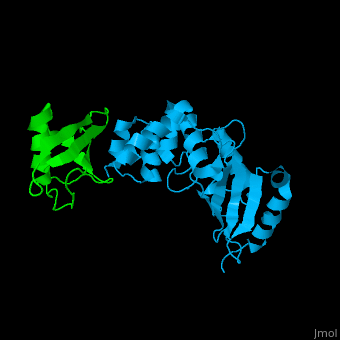Ubiquitin
From Proteopedia
(Difference between revisions)
| Line 1: | Line 1: | ||
<StructureSection load='' size='340' side='right' caption='Human ubiquitin (green) complex with ubiquitin-conjugating enzyme E2 (deep sky blue), [[3k9p]]' scene='41/417541/Cv/3' > | <StructureSection load='' size='340' side='right' caption='Human ubiquitin (green) complex with ubiquitin-conjugating enzyme E2 (deep sky blue), [[3k9p]]' scene='41/417541/Cv/3' > | ||
== Function == | == Function == | ||
| - | [[Ubiquitin]] (UBB) is found in almost all cells. It binds to proteins tagging them for destruction in the proteasome. UBB is activated by the UBB-activating enzymes E1, E2 and E3. UBB+1 is a frameshifted mutant of UBB observed in several diseases. A dimer of UBB (DiUBB) is formed by linkage of K48 to the C-terminus of a second UBB molecule. '''Polyubiquitin''' (polyUBB) is a chain of ubiquitin molecules bound by peptide bonds. PolyUBB can be formed by lysine residues: K6, K11, K27, 29, K33, K48, and K63. Different lysine linkages convey different functions to polyUBB. Lys48- linked polyUBB | + | [[Ubiquitin]] (UBB) is found in almost all cells. It binds to proteins tagging them for destruction in the proteasome. UBB is activated by the UBB-activating enzymes E1, E2 and E3. UBB+1 is a frameshifted mutant of UBB observed in several diseases. A dimer of UBB (DiUBB) is formed by linkage of K48 to the C-terminus of a second UBB molecule. '''Polyubiquitin''' (polyUBB) is a chain of ubiquitin molecules bound by peptide bonds. PolyUBB can be formed by lysine residues: K6, K11, K27, 29, K33, K48, and K63. Different lysine linkages convey different functions to polyUBB. Lys48- linked polyUBB and LYs11-linked polyUBB are associated with proteasome degradation; Lys63-linked and Lys-6 polyUBB are associated with non-proteolytic functions<ref>PMID:18438605</ref>. At least 4 UBB molecules are needed to tag a protein for the proteasome<ref>PMID:9759494</ref>. <scene name='41/417541/Cv/4'>Human ubiquitin interactions with ubiquitin-conjugating enzyme E2</scene> ([[3k9p]]). For details see<br /> |
* [[Ubiquitin Structure & Function]]<br /> | * [[Ubiquitin Structure & Function]]<br /> | ||
* [[Ubiquitin and Ubiquitination]]<br /> | * [[Ubiquitin and Ubiquitination]]<br /> | ||
Revision as of 08:12, 22 February 2024
| |||||||||||
References
- ↑ Li W, Ye Y. Polyubiquitin chains: functions, structures, and mechanisms. Cell Mol Life Sci. 2008 Aug;65(15):2397-406. PMID:18438605 doi:10.1007/s00018-008-8090-6
- ↑ Hershko A, Ciechanover A. The ubiquitin system. Annu Rev Biochem. 1998;67:425-79. PMID:9759494 doi:http://dx.doi.org/10.1146/annurev.biochem.67.1.425
- ↑ Neefjes J, Groothuis TA, Dantuma NP. [The 2004 Nobel Prize in Chemistry for the discovery of ubiquitin-mediated protein degradation]. Ned Tijdschr Geneeskd. 2004 Dec 25;148(52):2579-82 PMID:15646859
- ↑ Paul S. Dysfunction of the ubiquitin-proteasome system in multiple disease conditions: therapeutic approaches. Bioessays. 2008 Nov;30(11-12):1172-84. doi: 10.1002/bies.20852. PMID:18937370 doi:http://dx.doi.org/10.1002/bies.20852
Proteopedia Page Contributors and Editors (what is this?)
Michal Harel, Alexander Berchansky, Joel L. Sussman, David Canner, Jaime Prilusky

